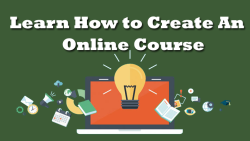
How To Sell Online Courses
Sharing your knowledge through workshops or master classes is an excellent way to generate extra income working from home. In this article, we are going to show you how and where to sell online courses without the need for programming knowledge, website creation and more.
Save this post in your favorites list so that you can consult it again or, even better, visit YTR Hub for new content every week in your email.
How to sell courses online?
Now that you know more about the options available to market your courses, let's talk about the sales process, from content creation and structure to promotion.
To sell online courses you have to follow these 5 steps:
- Choose your audience and set your course goals
- Create support material for your classes
- Select a platform to sell online courses
- Publish your course on the platform you chose
- Promote it on social media and by email
Let's see in detail the 5 steps to sell courses online.
1. Choose your audience and set your course goals
If you believe that the topic you want to talk about is of general interest, it is likely that you will not end up attracting a specific segment. For this reason, it is important to define in the first instance who your course is going to be aimed at.
To do this, we recommend answering the following questions:
- Who is my ideal audience?
- How old is he on average?
- Where do my students live?
- Do they require prior knowledge or an advanced level in the subject?
- What do my students want to achieve?
- What are they going to learn?
- What worries you?
- What is the objective of my course?
- Who is my competition?
- Are there online courses similar to mine?
- What is the differentiating element of my course?
Based on these answers, you can build a fictitious character of one of your students and with this "X-ray" start creating the course content, from the objective and approach to the exercises that you are going to include.
This character is called a buyer persona, one of the key tools for designing your sales strategy.
Don't forget the price!
Perhaps you consider that this is one of the last things to define; however, we suggest you do it at the beginning.
Setting the price helps determine how much time to invest in making the pieces of your course or the complexity you want in your content. To define it, you can guide yourself by answering these questions:
- How much do courses similar to mine cost?
- Where are they staying?
- How many hours will I invest in doing my course?
- Is it an attractive price for my audience?
In addition, you have to consider the cost of the platform that you are going to use to host the course, as well as the budget that you are going to allocate to promotion and dissemination.
If you have doubts about this point, we recommend that you read this article that explains how to calculate the sale price of a product or service.
Additionally, we share two free resources that will be very useful:
- cost structure worksheet
- Pricing Worksheet
2. Create the support material for your classes
Some of the formats that you can use to create your online course materials are:
- podcast;
- Video classes or video tutorials;
- e-books;
- digital bibliography;
- Audiobooks;
- Webinars or live classes.
After defining the formats, use this checklist to cover the necessary elements (feel free to incorporate the items you consider!):
- Course name
- Name of the facilitator
- Date
- Access link
- Overall objective
- Skills to develop
- Introduction or presentation
- Methodology
- Evaluation form
- Reference bibliography
3. Select a platform to sell online courses
With the materials built, it's time to host them on the platform of your choice. The two most used options for selling online courses are:
Through an online training platform. Platforms enabled for e-learning allow professionals and academics to upload their courses and profit from their digital products.
They are quite functional and some even allow you to block content to protect it, keep track of students and schedule assessments to check knowledge.
On your own website. This option is ideal for those who prefer to manage a single space to sell their course, also for those who wish to have full control of their materials, as well as offer more services, such as downloading e-books and other learning tools.
Keep in mind that, in this case, it is important to define how you are going to deliver this digital product to your buyers and students.
4. Publish your course on the platform you chose
For this it is necessary that you complete the following elements:
- Course name
- Description
- Goals
- Table of Contents
- Preview to chapters or modules
- Cost
You can also add your resume or a short excerpt from your story. This is a great way to share with your prospective students what your background is and what makes you an expert in the topic you are developing.
5. Promote it on social networks and by email
These dissemination channels are true allies to publicising your course. In the case of social media, you can do both organic posts and banner ads.
For example, if you want to spread and sell your course on Facebook, we recommend that you follow these steps:
- Create your Facebook page in the tutor/teacher category.
- Activate the “Shop” function on your Facebook page.
- Create a catalog for your courses and upload the files of your products.
- Add to the dates of your products the link of your web page to direct them to your site.
- Wait for Facebook to approve the articles.
Now, if you want to carry out your dissemination strategy on Instagram, we advise you to create a business account, plan your content so that your feed is truly attractive, make the most of other elements such as Stories and Reels, and encourage yourself to create your campaigns in Instagram Ads.
Lastly, include email marketing actions in your dissemination plan. To do this, you can create a newsletter and share both the information about your online course and content of interest on the subject of your classes.
Bonus: promote your course with Google Ads
Another great option to promote your online course is to do it with ads on Google. Yes, they are those ads that appear in a preferential place in the search engine results.
Here we tell you how to do it:
- Create your Google Ads account
- Create the first campaign on the platform.
- Select in which parts of the search engine and the Google ecosystem you want your ad to appear.
- Define what type of audience you would like your ad to appear to.
- Establish the budget that you are going to invest in the campaign.
- Create your ad group, choosing the keywords associated with your course.
- Include links to your site or the platform where your course is hosted in your ad set.
- Accept your campaign settings and allow it to go into action.
Conclusion
Selling online courses can be a lucrative and fulfilling way to share your knowledge and expertise with a wide audience. By creating high-quality content, promoting your courses effectively, and building a strong brand, you can succeed in the online education market.
Remember to listen to your students and continually improve your courses to provide the best possible learning experience. With dedication and hard work, you can turn your passion into a successful online course business.
If you're looking to become a course creator, content creator, gaming YouTuber, or fashion YouTuber, there are many resources available to help you get started. Similarly, if you're interested in becoming a youtube influencer, there are many resources available to help you earn money online.
One platform to consider is a digital storytelling platform, which can help you share your story with a wider audience.




















